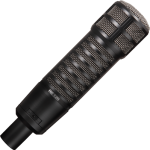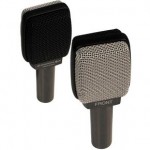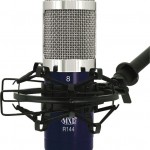The three I’ll talk about would be great for all kinds of recording. I have plenty of experience getting the most out of a few affordable mics, and if I were starting over building a home recording rig, these would be my first three. Let my experience save you some time, money, and headaches.
 Electro-Voice RE-320 – This go-to dynamic mic sets a solid baseline sound for almost any sound source – vocals, amps, acoustic instruments – and is my favorite kick drum mic (with the EQ switch engaged) to boot.
Electro-Voice RE-320 – This go-to dynamic mic sets a solid baseline sound for almost any sound source – vocals, amps, acoustic instruments – and is my favorite kick drum mic (with the EQ switch engaged) to boot.
 Sennheiser e 609 silver – Drew and I love this dynamic mic on guitar cabinets and snare drum.
Sennheiser e 609 silver – Drew and I love this dynamic mic on guitar cabinets and snare drum.
 MXL R144 – I confess; my experience with ribbon mics is limited. However, it’s the bang-for-your-buck on the R144 that vaults it onto this list. It provides a detailed, live, balanced sound, and the figure-8 pattern is handy in the studio. There have been some concerns about quality control regarding the affordable, mostly Chinese-manufactured ribbon mics that have come onto the scene, so while my experience has been really good, be aware of that.
MXL R144 – I confess; my experience with ribbon mics is limited. However, it’s the bang-for-your-buck on the R144 that vaults it onto this list. It provides a detailed, live, balanced sound, and the figure-8 pattern is handy in the studio. There have been some concerns about quality control regarding the affordable, mostly Chinese-manufactured ribbon mics that have come onto the scene, so while my experience has been really good, be aware of that.
Here’s how I’d typically use these mics for all kinds of sounds:
Vocals – Set up the RE-320 and R144 side-by-side at the singer’s mouth level (standard positioning) with the diaphragm and ribbon in line (i.e. the mics in phase), with a pop filter and the singer 12-18 inches away. In the mix I’d start with the levels about equal, though I’d experiment with bringing one or the other forward to see if that worked better.
Drums – RE-320 on the kick opposite where the beater strikes the batter head, 6-18 inches from the resonant head. e 609 on the snare, however you like your snare close-mic’d. R144 in a drummer’s shoulder, overhead, or front-of-kit position, whatever sounds best and gives you the level of ambience you want (shouder = least ambience, front-of-kit = most ambience). You’ll be amazed at the full, detailed drum sound you can get with just these three mics; much better, I think, to spend your money on the EV and MXL mics than get one of those sets of six or more cheaper drum mics that let you close-mic everything, but with lower quality.
Electric guitars – e 609 close up on the speaker cabinet in your favorite position, R144 three to six feet back, centered on the speaker configuration. This combination will give you a great guitar sound, and you can mix the R144 up or down to affect the presence and space of the guitar in the mix.
Acoustic guitars – Play with a combination of the RE-320 and R144 in different positions (watch phase!), though either one on its own will do a good job, too. Emphasize one or the other in the mix.
Bass guitar – Put the RE-320 on the speaker cabinet, and also take a direct line in from the bass. I use the 320 as my main sound in the mix, and bring in just enough of the direct line to support the mic sound.
“Wait, what about the Shure SM57?!!”
It’s a workhorse, I agree, but both Drew and I prefer the e 609 for the classic ’57 applications; snare and guitar cabinet.
“Not a single condenser mic?!?”
I love condensers. My go-to is a Rode NT-1 that I’ve had for a long time and am happy with, so I’m not super up-to-speed on what’s out there now, and I might make a different choice today if I were buying a first condenser mic. But for a small, affordable mic locker to do the best job possible on all the applications above, I’ve found the RE-320 + R144 combination to be superior to anything we can do similarly with our condenser mics from the same price range.
